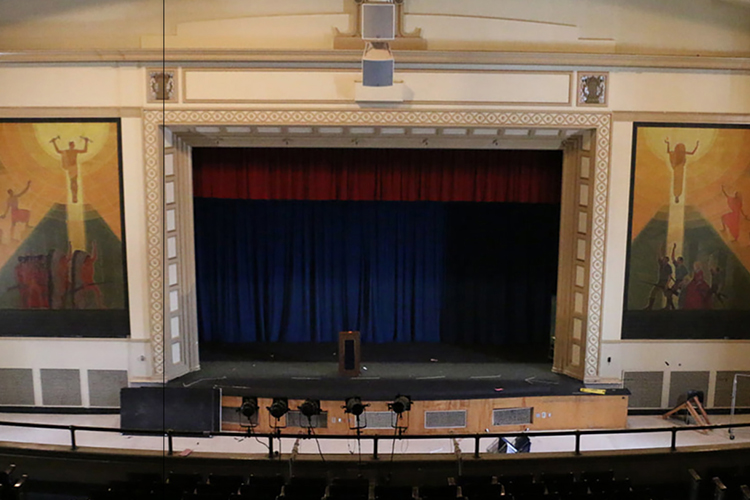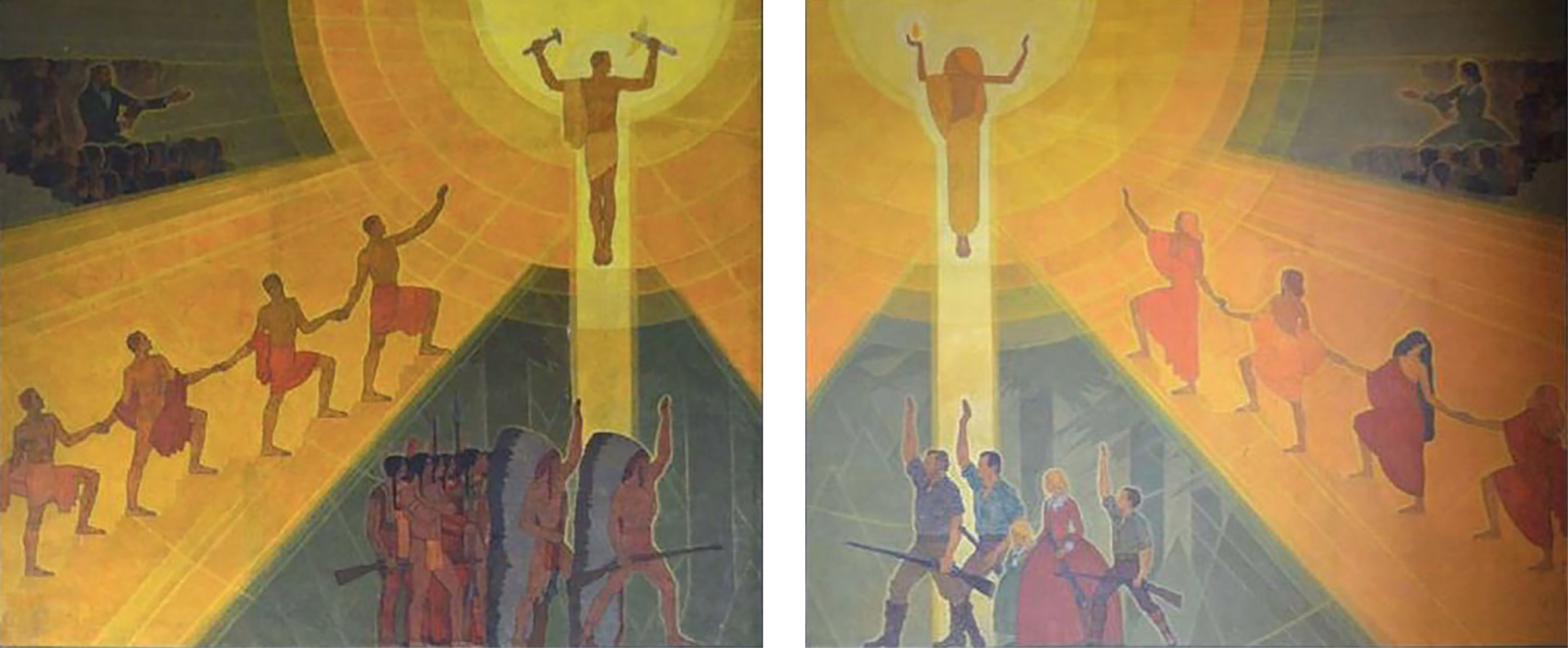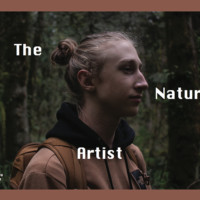
It is 2015, and the Grant High School auditorium bustles as hundreds of nervous freshmen pour through its doors. Mischa Brown is among this crowd, anxiously anticipating the start of freshman orientation. As Brown goes to find a seat, she is distracted from the chatter of her peers by the two massive murals, which hang on either side of the stage in the Grant auditorium and take up almost the entire wall.
While her friends anxiously talk with each other, Brown seems to be the only one aware of these murals. Her eyes immediately dart to the bottom corners, which depict Native Americans greeting a group of pilgrims.
Brown feels herself tense as she looks at the murals, titled “The Ideals of Education.” The murals’ depiction of Native Americans and pilgrims conflicts with what she knows about the relationship between natives and settlers.
The murals are two images, each composed of four canvases. On the left and right side, men and women ascend a staircase toward two figures believed to be Prometheus and Athena, while Ulysses S. Grant and Susan B. Anthony are painted in the upper left and right-hand corners. Below the staircase on the left is a group of Native Americans bearing bows and spears in historically inaccurate headdresses, while on the right is a group of pilgrims holding rifles. The groups face each other without weapons drawn.
Brown, who is a Native Alaskan of the Alutiiq people, feels confused and frustrated. “My family, and my tribe and I know every Native person in the U.S. has dealt with so much adversity and racism because of colonization,” says Brown. “And seeing murals like that depicting this false, whitewashed narrative is really difficult.”
Now a senior and co-leader of Grant’s Native American Student Union (NASU), Brown and the NASU are advocating to remove the murals from the Grant auditorium as part of the Grant remodel.
However, the Grant High School Alumni Association (GHSAA) firmly believes that the murals must be restored. To the GHSAA, the intent behind the message of the murals is the most crucial aspect of them. “I think they have a lot of meaning and should remain,” says GHSAA member Kathi Stipe Swanson.
According to John Hamnett, who is leading the restoration project with the GHSAA, the murals’ depiction of Native Americans and pilgrims coming together represents equality, education and peace among people.
Therein lies a significant problem with the murals, according to Raymond Tate, Grant math teacher and advisor of NASU. Native Americans and Pilgrims never came together in a grand movement of peace. Hundreds of thousands of Natives died at the hands of the pilgrims. “It is a false portrayal of history, of what things have happened,” says Tate. He says that some of the inaccuracies portrayed in the murals include, “people laying their arms down, and also even to a point … certain types of weapons were carried by the Natives.”
The restoration is estimated to cost $200,000. If the process requires the murals to be taken down from where they currently hang, however, refurbishing the murals could cost up to $400,000.
In early April, the NASU met with the GHSAA to discuss the future of the murals and voice their concerns about the impact they have on Native students. The GHSAA was open to hearing their perspective but did not consider halting the restoration effort.
As of April 20 of this year, the GHSAA had collected more than enough donations to reach a goal of $100,000 to go toward restoring the murals. The Leo Lester Browne Charitable Fund, a foundation in the honor of the late Portland Public Schools teacher Leo Browne, matched this amount. According to the GHSAA website, the murals are “the most significant and valuable cultural heritage asset at Grant High School.”
While students don’t have the ability to decide to take the murals down, the NASU is pushing to start a broader conversation regarding the murals. Much of the Grant student body remains entirely unaware.
“I definitely don’t think it’s being talked about,” says Isabel Lickey, a Grant senior. Lickey says that she is aware of the discussion around the murals because she has a friend who is part of NASU, although she is not Native American or an NASU member herself. “If you weren’t involved in clubs like NASU, you wouldn’t know a lot about the mural debate,” she says.
Lickey hopes that as NASU continues to advocate for the removal of the murals, Grant students outside of the club will become aware of the issue. “It’s something that’s gonna impact people going into Grant, and also I think it’s just … important to listen to the requests of the students,” she says. “If NASU is saying, ‘We want this to come down,’ I think that it is important for the rest of the Grant student body to listen to that and try to help them achieve that goal.”
“If NASU is saying, ‘We want this to come down,’ I think that it is important for the rest of the Grant student body to listen to that and try to help them achieve that goal.” -Isabel Lickey
‘The Ideals of Education’ murals were painted from 1925 to 1927 by artist Carl Hoeckner. Hoeckner, who was born in 1883 in Germany, immigrated to the United States in 1910. After years of studying, practicing and teaching art, he became a notable modernist artist in Chicago, Illinois. Hoeckner received a commission for ‘The Ideals of Education’ during the Works Progress Administration in honor of the first Grant principal, William Thomas Fletcher.
The historical significance of the murals is crucial to the GHSAA and is the main reason that they are working to have them restored. According to Hamnet, the murals are culturally and historically meaningful, despite not necessarily having a monetary value. The GHSAA believes that, although the murals are not entirely historically accurate, it is essential to honor the ideas that they are supposed to represent, along with the memory of William Thomas Fletcher, whom they are dedicated to.
“To give the murals the respect they deserve, it is incumbent for the school administrators to educate Grant High School students about the history and meaning of the murals including the historical inaccuracies along with the ideals for excellence in our journey toward education, equality and peace,” said Hamnett in an email. “Symbols in the murals represent these ideals; thus the title The Ideals of Education. We continue to strive for these ideals – the ascent of students in their quest for education, knowledge and wisdom, the equality of all people, and peace among all.”
Because of the lack of accuracy of the murals, some teachers have spoken out against refurbishing the murals. One is photography and graphic design teacher Lynn Yarne. “A more truthful narrative about how Native Americans were treated was genocide. To this day there’s still a lot of inequality and not having support for our Native communities,” she says. “So when you have this mural that’s pilgrims or settlers coming in and putting up their weapons and joining the Native Americans, that’s a nice idea — that everyone got along fine — but I don’t feel like that’s accurate in history.”
Yarne helped organize a meeting with Grant’s student Equity club, and invited members of the Oregon Department of Education Office of Indian Education, Friends of Noise and the Regional Arts and Culture Council, to create a platform for NASU to present their perspective and ask for support. “Especially as an arts teacher and someone with investment in our community and the school next year, I’ve been concerned about it,” says Yarne of the restoration project. “Whether or not people feel it’s right or wrong as a mural, I think if there’s discussion and activity going around community-wise I think it’s healthy … for people to know and think on it,” she says. At the meeting, which took place on April 22, NASU connected with the above resources that would help them continue their advocacy by directing them to conferences and board members sympathetic to their goal.
Grant’s administration has also said that they are in favor of NASU’s efforts.
Despite this, there has been no decision regarding a way to completely halt the refurbishment efforts. Members of NASU have been left wondering why the decision to restore the murals is entirely up to the GHSAA. “The fact that so much money is put into it by people that don’t go here anymore, it’s kind of weird,” says senior Toli Tate, Raymond Tate’s daughter and co-leader of NASU.
According to Ramona Halcomb — the Indian education specialist in the Office of Indian Education at the Oregon Department of Education — this alumni-led decision could have negative impacts on current Native American Grant students. Halcomb believes that the misrepresentation of history in the murals can bring up historical trauma for Native students.
“One image, what some might think, and obviously the Alumni Association thinks it’s insignificant, can have a large impact with that cumulative knowledge and information. It’s just an area where people can be re-traumatized,” she says.
Brown agrees. “It’s taking away all of the struggle and issues that our ancestors faced,” she says. Brown feels that the misrepresentation of history depicted in the murals may harm non-Native students as well. “I think it allows racism and ignorance to continue when these stories are not taught properly,” she says.
As of April 20, 2019, the GHSAA has begun taking steps to start the restoration process. Hamnet is drafting a brochure that will provide information on the history of the murals, to hand out to students and community members once the murals have been restored. He will include multiple perspectives on the murals, including NASU’s ideas, and those of William Thomas Fletcher’s grandchildren. Of the discussion over the murals, Hamnet says, “The best thing about it is it’s made people aware of the murals and how they relate back and how they relate to the future.”
In addition to opposing refurbishing the murals, NASU is planning to create their own mural to represent Native culture and history more accurately. Grant senior Maya McDarragh has agreed to design this mural, which will be slightly smaller than the Ideals of Education murals. McDarragh hopes to begin painting her mural with members of NASU as soon as possible and has already started working on its design.
“To give the murals the respect they deserve, it is incumbent for the school administrators to educate Grant High School students about the history and meaning of the murals including the historical inaccuracies along with the ideals for excellence in our journey toward education, equality and peace.” -John Hamnett
“We want it to be a more accurate … representation of Native power and Native culture,” says Toli Tate. “And also, in a way, a memorial to the fact that everyone that goes to Grant — is in the Grant community — is on Native land.”
McDarragh is unsure of whether she will be able to paint the mural before she graduates. She plans to design it and likely will get help from NASU members to paint it. Ideally, this mural will hang near the original murals to provide commentary on them.
With NASU’s mural, McDarragh wants to “actually identify the individuals who are Native American today, instead of this generic image of a Native American,” she says. “To give a face to the individual of who Native Americans are today.”
NASU intends to continue their conversation with the GHSAA about the murals. They feel that they lack the power to halt the restoration project because they are students. However, in creating their mural and taking steps to educate the Grant community, they hope to start a more extensive discussion about the murals and the misrepresentation of Native Americans they perpetuate.
“I think it’s really important to continue to have a good relationship with them and I respect their point of view and I understand where they’re coming from, I just don’t agree with it,” Brown says of the GHSAA. “I think that using this as an opportunity for conversation is really important and meaningful because it can do a lot to change the situation that Native students are put in.”





